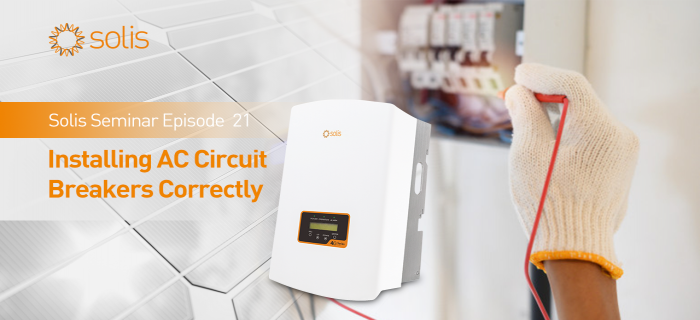
Solis Seminar Episode 21: Installing AC Circuit Breakers Correctly
Background
Recently, a customer reported that the circuit breaker in the fuse box of the newly installed solar PV system was experiencing an abnormal arc when it was disconnected. The customer suspected that it was caused by the inverter, however, a Solis technical engineer discovered that the circuit breakers were reversed fed. After replacing the circuit breaker and wiring it correctly on site, the arc disappeared. in this Solis Seminar, we will analyze in detail why the circuit breaker must not be reversed (power line enters the load terminal of the circuit breaker) using this example and what harm it will cause.
Reverse Feeding of AC Breaker
Normal wiring and reverse wiring In the fuse box, the power interface is on the top and the load interface is on the bottom. When installing the PV system for grid connection, you will add an additional circuit breaker. In order to save material costs, installation space and reduce installation workload, some installers choose to use the bottom-in and top-out method (reverse wiring).
However, many miniature circuit breakers generally do not allow such wiring because of the limitation of current direction, which as shown in the figure below.
![]()
Risks of Reverse Wiring
1. Principles of Extinguishing Circuit Breaker Arcs
An electric arc is formed between the contacts of a circuit breaker when it interrupts the current flow to loads during normal operation. In the event of short circuits, the arc formed will be more intensive than a normal one. Metal plates in arc chutes are made of ferromagnetic material to ensure the any arc formed is attracted towards the plates and moves towards the arc chutes through the arc runners.
As it reaches the arc chute, the structure of the arc chutes widens the arc further and split it into small segments. This increases the length of the arc. It then cools down and eventually gets extinguished (as shown in Figure below).
2. Potential Damage Due to Reverse Wiring
- Incomplete arc extinguishment. Thiswill cause longer arc time between moving contact and static contact, which cannot be quickly extinguished through the arc extinguishing chamber, causing part of the arc to escape.
- The braided wire, bimetallic sheet and the common rotating shaft are always under the power supply voltage, which will cause them to age rapidly.
- The input circuit contains components such as electromagnetic coils, therefore the switching impedance will be higher than that of normal wiring. The transient recovery voltage will be higher when the circuit is disconnected. It is more difficult to extinguish the arc and this will cause the contact heat to accelerate aging, and a long-term switch action will cause the circuit breaker to be damaged (shown in the figure below).
Solution
There are many circuit breakers with a margin of breaking capacity, so it is often seen that some circuit breakers are nominally capable of reverse wiring. Solis recommends to very all AC wiring are normal and not in a reverse wiring state for ongoing safe and stable operation of your system.
Conclusion
When installing a circuit breaker in a PV system, pay attention to reverse wiring of the circuit breaker. If absolutely needed, choose reverse wiring, and pay attention to the use voltage and breaking current specified by reverse wiring. If it is not clearly marked that the device can use the reverse wiring method, you need to confirm with the circuit breaker manufacturer and install it to ensure the long-term safe operation of the PV system.

.gif)
.jpeg)
leave your comment